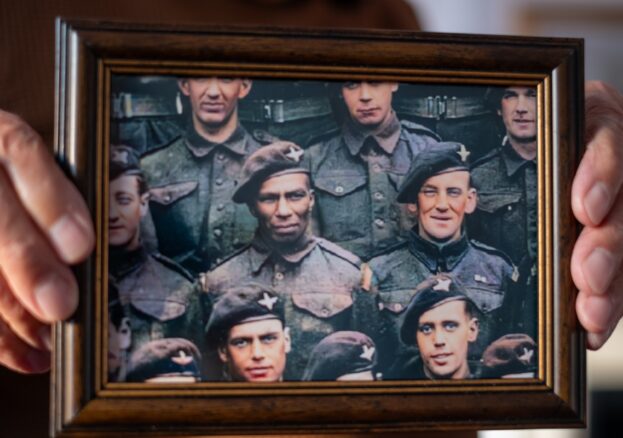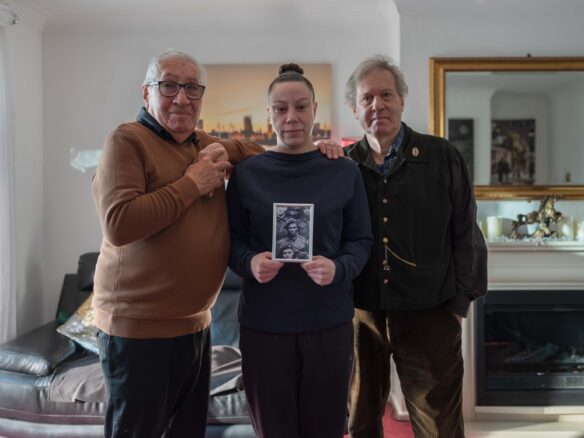
This year saw marked the 80th anniversary of D-Day, a pivotal moment in the Second World War, when the Allies began the liberation of western Europe. Among the countless stories from Normandy is that of Sgt Sidney Cornell, and his descendants’ journey to find out about his life.
Sidney was born on Boxing Day 1913 in Portsmouth. His father was the African American circus performer, Charles Cornell, who came from Connecticut and settled in England in the 1890s, and his mother was a gardener’s daughter from Somerset.
Sidney married his childhood sweetheart, Eileen, in 1934, and they set up home in Portsmouth. His great nephew Chris leads the family research. He was aware that Sidney was a war hero but it was a chance conversation with Floella Benjamin, and comparing their heritage of family members who settled in England, that led him to delve into the past. Research into the 1901 Census and the National Archive yielded important information, and Chris began talking to family members about their heritage.

Says Chris: “Sidney became quite a local amateur boxing champion. One of the stories that is told when I interviewed my dad’s cousin, was that they remember going to one of the fairs on Portsdown Hill, which is a local annual event where there used to be boxing booths where the fair owners would have their own champions. And then the idea was that they’d get people to come and challenge their champion. And if you beat the champion, you’d get a fiver or whatever. And over time, Sidney was actually banned from these booths, because he was always winning.”
Sidney was working as a driver for builder’s merchants when in 1942 he enlisted in the Army. Chris says: “I think that to join up and become a fighting man, to do your bit, was instilled with him already. He wasn’t going to just lay back and let other people do it and, in the end, he just showed himself as somebody who was going to fight on and, because of his age, he was quite well respected by the men”.
Sidney was deployed as a driver before he volunteered to join the Parachute Regiment and begin training. In the very early hours of 6th June 1944 Sidney parachuted behind enemy lines with 7th Parachute Battalion near Pegasus Bridge. He is believed to be one of the first Black soldiers to land in France on D-Day. His role was to deliver vital messages under enemy fire. This was one of the most dangerous jobs in Normandy, where the front line of fighting was continually moving, and he faced heavy mortar and machine gun fire.
Chris explains: “He was just in the thick of it and his job was to be the Company runner. He was running around, there were bullets pinging all over the place. They said he got wounded in the shoulder, and probably the leg, about four wounds in all, but he just carried on regardless. And that was the thing, he wasn’t going to let a wound in the shoulder stop him. He could have been taken out of the field and sent home, but he was determined not to. He was working closely with his senior officers because that was part of his job. He was literally a messenger between them all.
“I know that on one occasion he went in with one of his senior officers and they captured a couple of Germans who were snipers and taking out their men. And he and another group went into a farmhouse and got the snipers out of there and captured them.”
In recognition of his bravery and professionalism throughout the Normandy campaign, Cornell was promoted to Sergeant and awarded the Distinguished Conduct Medal. His citation reads includes the passage: ‘His courage and many wounds have made him a well known and admired character throughout not only his own battalion but also the whole brigade. Space does not permit a record of all his feats as he distinguished himself in practically every action and fighting took place daily.’
After the Battle of Normandy, Sidney and his colleagues were deployed in the Ardennes and then in March 1945 they parachuted into Germany as part of the ambitious Operation Varsity, to secure strategically important territories and bridges. On 7th April Sidney’s battalion reached the town of Neustadt am Rübenberge, but found its bridge wired with explosives.
They immediately rushed it, hoping to surprise the defenders and keep the bridge intact, but an arch was blown as they crossed. Sidney was one of 22 of his battalion killed that night. Chris reflects: “In a month the War (in Europe) had finished. We should be grateful he survived Normandy, but sadly he didn’t reach the War’s end”.
Sidney’s legacy lives on. He has been a catalyst to bring his descendants together. Chris established a facebook group to share information and images, and met his cousin Garry for the first time as a result of exploring Sidney’s story. Chris is also now in contact with cousins in the USA. A version of Sidney exists in the digital realm as well. The makers of the video game Call of Duty based one of their lead characters, Arthur Kingsley, on Sidney Cornell.
Reflecting on his great uncle during the War, Chris says: “I don’t think he was thinking ‘I’m going to be the hero’. He was just doing his job and standing up for himself and his comrades. Which is what he did, as a kid in Portsmouth and throughout his life. He just learned to defend himself and others.”
